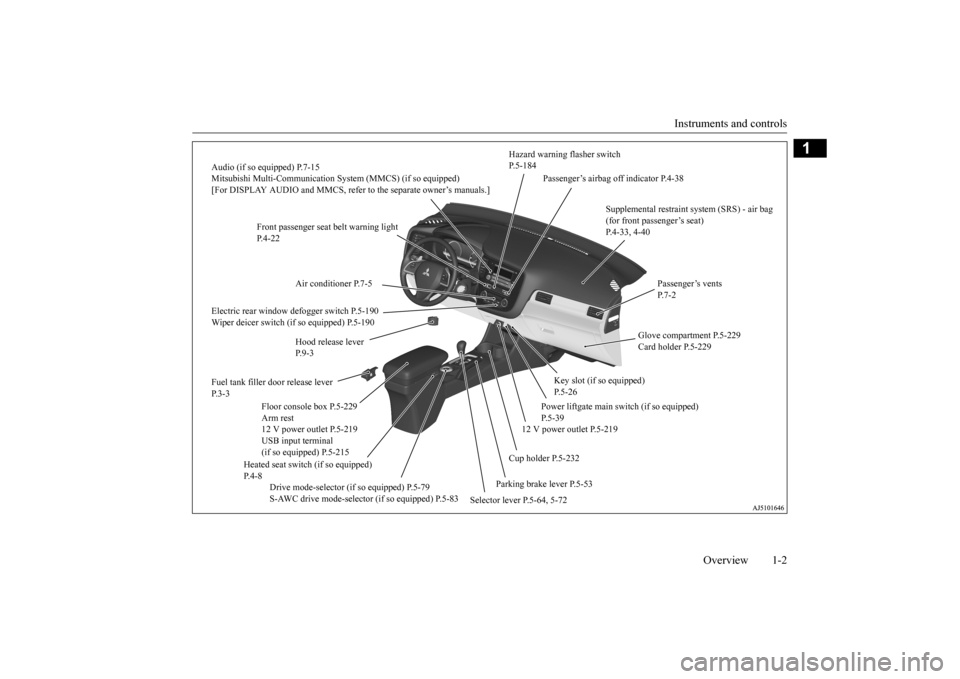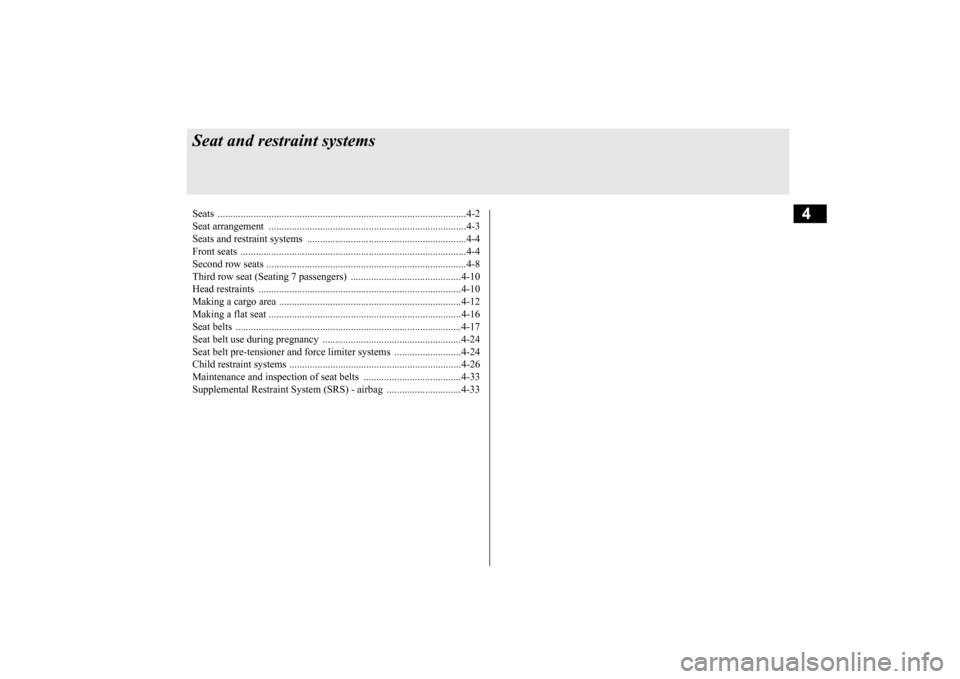Page 1 of 464
Table of contents
123456789101112
Overview Quick indexGeneral information Seat and restraint systems Features and controlsDriving safetyComfort controlsFor emergenciesVehicle care a
nd maintenance
Customer assistance/
Reporting Safety Defects
SpecificationsAlphabetical index
BK0223400US.book 1 ページ 2015年2月13日 金曜日 午後12時15分
Page 3 of 464

Instruments and controls
Overview 1-2
1
Audio (if so equipped) P.7-15 Mitsubishi Multi-Communication Syst
em (MMCS) (if so equipped)
[For DISPLAY AUDIO and MMCS, refer to the separate owner’s manuals.]
Hazard warning flasher switch P.5-184
Electric rear window defogger switch P.5-190 Wiper deicer switch (if so equipped) P.5-190 Fuel tank filler door release lever P. 3 - 3
Drive mode-selector (if so equipped) P.5-79 S-AWC drive mode-selector (if so equipped) P.5-83
Selector lever P.5-64, 5-72
Parking brake lever P.5-53
Supplemental restraint system (SRS) - air bag (for front passenger’s seat) P.4-33, 4-40
Air conditioner P.7-5 Hood release lever P. 9 - 3
Floor console box P.5-229 Arm rest 12 V power outlet P.5-219 USB input terminal (if so equipped) P.5-215
Heated seat switch (if so equipped) P. 4 - 8
Cup holder P.5-232
12 V power outlet P.5-219
Power liftgate main sw
itch (if so equipped)
P.5-39
Key slot (if so equipped) P.5-26
Glove compartment P.5-229 Card holder P.5-229
Passenger’s vents P. 7 - 2
Passenger’s airbag off indicator P.4-38
Front passenger seat belt warning light P.4-22
BK0223400US.book 2 ページ 2015年2月13日 金曜日 午後12時15分
Page 4 of 464
Interior 1-3 Overview
1
N00100302372
Interior
Sun visors P.5-218 Vanity mirror P.5-218Card holder P.5-218
Supplemental restraint system (SRS) - side airbag (for front seats) P.4-44
Sunglasses holder (if so equipped) P.5-231
Adjustable seat belt shoulder anchor P.4-23 Seat belts P.4-17
Cargo room light P.5-227, 9-32
Electric remote-controlled outside
rearview mirrors switch P.5-58
Lock switch P.5-50
Power door lock switch P.5-35
Power window switch P.5-49
Second row seat P.4-8
Third row seat (7 persons) P. 4 - 1 0
Dome light (rear) P.5-226
Inside rearview mirror P.5-55 HomeLink
® Wireless Control System (if so
equipped) P.5-220 Front seat P.4-4
BK0223400US.book 3 ページ 2015年2月13日 金曜日 午後12時15分
Page 22 of 464

Filling the fuel tank 3-4 General information
3
All-wheel drive vehicles: 15.8 gal (60 L) Front-wheel drive vehi
cles: 16.6 gal (63 L)
1. Before filling with fuel, stop the engine. 2. The fuel tank filler is located on the rear driver side of your vehicle. The fuel tank filler door can be openedfrom inside the vehicle with the fuel tank filler door release lever located at the left side of the driver’s seat. 3. Open the fuel tank filler pipe by slowly turning the fuel tank filler cap counter- clockwise.
Before removing the fuel tank filler cap, be sure to get rid of your body’s staticelectricity by touching a metal part of thecar or fuel pump. Any
static electricity on
your body could create a spark that ignites fuel vapor. Perform the whole
refueling process
(opening the fuel tank filler door, remov-ing the fuel cap, etc.) by yourself; do not let any other
person near the fuel tank
filler. If you allowed
a person to help you
and that person was ca
rrying static elec-
tricity, fuel vapor could be ignited. Do not move away from
the fuel tank filler
until refueling is fi
nished. If you moved
away and did somethin
g else (for example,
sitting on a seat) part-way through the refueling process, you could pick up a fresh charge of st
atic electricity.
Be careful not to inhale fuel vapor. Fuel contains toxic substances. Keep the doors and wi
ndows closed while
refueling the vehicle. If they were open,fuel vapor could ge
t into the cabin.
Fuel tank capacity
WA R N I N G
Refueling
1- Remove 2- CloseWA R N I N G Since the fuel system may be under pres- sure, remove the fuel tank filler capslowly. This relieves
any pressure or vac-
uum that might have built up in the fuel tank. If the cap is venting vapor or if youhear a hissing sound, wait until the sound stops before removing the cap. Otherwise, fuel may spray out, in
juring you or others.
NOTE
While filling with fuel
, hang the fuel cap on
the hook (A) located on the inside surface ofthe fuel tank filler door.
BK0223400US.book 4 ページ 2015年2月13日 金曜日 午後12時15分
Page 27 of 464

4
Seat and restraint systemsSeats .................................................................................................4-2 Seat arrangement .............................................................................4-3 Seats and restraint systems ..............................................................4-4Front seats ........................................................................................4-4 Second row seats .........
...........
...........
...........
...........
...........
.........
.....4-8
Third row seat (Seating 7 passengers) ...........................................4-10Head restraints ...............................................................................4-10 Making a cargo area .......................................................................4-12 Making a flat seat ...........................................................................4-16Seat belts ........................................................................................4-17 Seat belt use during pregnancy ......................................................4-24 Seat belt pre-tensioner and force limiter systems ..........................4-24Child restraint systems ...................................................................4-26 Maintenance and inspection of seat belts ......................................4-33 Supplemental Restraint Syst
em (SRS) - airbag ......
.........
.........
.....4-33
BK0223400US.book 1 ページ 2015年2月13日 金曜日 午後12時15分
Page 29 of 464
Seat arrangement
Seat and restraint systems 4-3
4
N00401701122
You may arrange your seats
in the following positions.
Seat arrangement
Seating 5 passengers
Seating 7 passengers
Ordinary use Flat seat
Page 4-16
Making a cargo area
Folding the second row seats Page 4-13 Folding the third row seats
Page 4-15
—
BK0223400US.book 3 ページ 2015年2月13日 金曜日 午後12時15分
Page 30 of 464

Seats and restraint systems 4-4 Seat and restraint systems
4
N00401601219
Your vehicle has seat
belts and other safety
features that help protect you and your pas- sengers in an accident.Seat belts are the most important safety device. When worn properly, seat belts can reduce the chance of serious injury or deathin various types of crashes. For added protec- tion during a severe fr
ontal collision, your
vehicle has a Supplemental Restraint System (SRS) with airbags for the driver and passen- gers. The seats, head restraints, and doorlocks also are safety equipment, which must be used correctly. Always check the following before you drive: That everyone in your vehicle is properly wearing their seat belt. That infants and small children are prop- erly secured in an appropriate child restraint system in the rear seat. That all doors are fully closed and locked. That seatbacks are upright, with head restraints properly adjusted.
Safety equipment cannot prevent injury or death in all motor ve
hicle accidents. How-
ever, you can help reduce the risk of injury or death, by following the instructions in thismanual.
N00401801426
Position the driver’s seat
as far back as possi-
ble while maintaining a position that still enables you to fully apply the pedals, easilycontrol the steering wh
eel and safely operate
the vehicle.
Seats and restraint systems
Front seats
WA R N I N G Do not attempt to adjust the seat while driving. This can cause loss of vehicle con-trol and result
in an accident.
After adjusting the seat, make sure that it is securely locked into position.Manual seat adjustment Power seat adjustment
To reduce the risk to the driver of serious injury or death duri
ng deployment of the
driver’s airbag, always
properly wear the
seat belt and adjust th
e driver’s seat as far
back as possible while maintaining a posi- tion that still enables
you to fully apply the
pedals, easily control the steering wheel, and safely operate the vehicle. To reduce the risk to the front passenger of serious injury or
death during deploy-
ment of the passeng
er’s airbag, always
properly wear the seat
belt and adjust the
front passenger’s seat as far back as possi- ble. Always place childr
en 12 years old and
under in the rear seat
and use appropriate
child restraint systems.CAUTION Make sure that the seat is adjusted by an adult. If it is adjusted by a child, an unex- pected accident might occur. Do not place a cushion
or the like between
your back and the seatback while driving. The effectiveness of the head restraints willbe reduced in the event of an accident. When sliding the seat
s, be careful not to
catch your hand or leg. When sliding or reclin
ing the seat rearward,
pay careful attention
to the second row seat
passengers.WA R N I N G
BK0223400US.book 4 ページ 2015年2月13日 金曜日 午後12時15分
Page 31 of 464

Front seats
Seat and restraint systems 4-5
4
N00401901326
Pull the seat adjusting lever up and slide the seat forward or backward to the desired posi-tion. Release the adjusting lever to lock the seat in place.
Operate the switch forward or backward to move the seat to the de
sired position. Release
the switch to lock the seat in place.
When adjusting the front seat while the sec- ond row seat is folded, be careful not toapply strong force to the flipped second rowseat cushion. Doing so could cause da
mage to the cover of
the front seat and the
fitting of the second
row seat cushion.CAUTION
To adjust the seat forward or backward Manual seat adjustment
WA R N I N G To make sure that the seat is securely locked, try to move
it forward or back-
ward without using
the adjusting lever.
Power seat adjustment 1- Forward (toward the front of the vehicle) 2- Backward (toward the rear of the vehi-
cle)NOTE
To prevent the battery from completely dis- charging, operate the
power seat with the
engine running.
BK0223400US.book 5 ページ 2015年2月13日 金曜日 午後12時15分